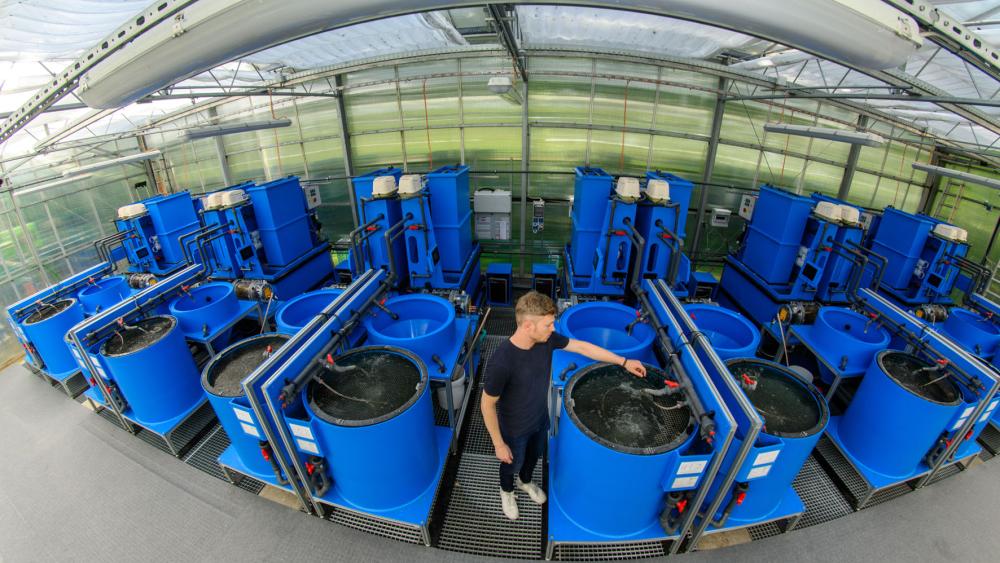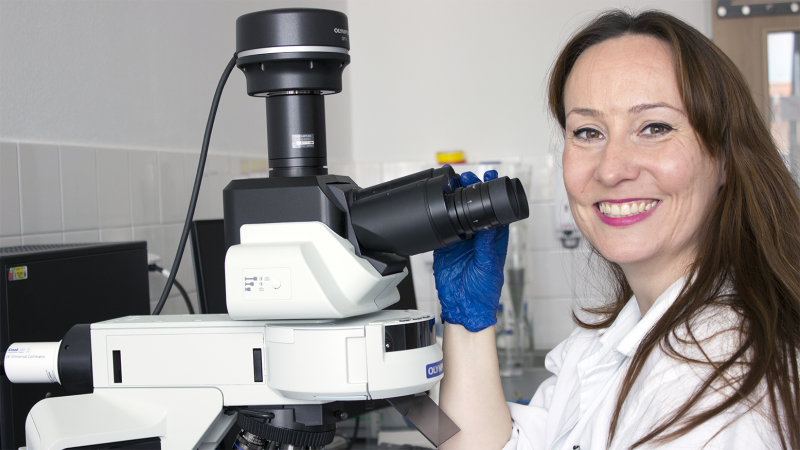
Christopher Shaw in the IGB fish facility, where he tests various feeds. | Photo: David Ausserhofer, IGB
Nowadays, more than half of the fish consumed comes from aquaculture rather than wild-caught fish. There is not just one type of aquaculture, but various forms of farming in freshwaters or in special facilities for the production of fish, crustaceans, molluscs, algae and other aquatic organisms. A large part of this takes place in so-called intensive farming, where the fish are fed with fish feed. The composition of the feed has a major influence on the health, growth and reproduction of the animals. However, feed is also a major cost factor for breeders and has an impact on the environment due to nutrient-rich wastewater. “When we think about how we want to make human nutrition more sustainable, we also have to start with the feeding of our farm animals”. said Prof. Werner Kloas, who heads aquaculture research at IGB.
In aquaponics, nutrients in process water are desirable as plant fertilizer
Aquaponics combines fish and plant cultivation in one system. This is particularly sustainable, as the water from the fish farm and the nutrients from the fish feed are used to grow the plants. Nutrients such as nitrate, phosphate and potassium in the process water from fish farming are therefore desirable in order to keep the need for mineral supplementary fertilizers for the plants as low as possible.
“In aquaponics, the nutrient composition in the rearing fish water corresponds at best to the plants' requirements. However, conventional fish feeds often do not have the ideal nutrient profile for the plants and are subject to certain restrictions in the composition of the ingredients in order to meet the goal of low wastewater pollution. This presents an opportunity to design fish feed for aquaponics in a more targeted way”, explained Dr. Christopher Shaw, who is investigating environmentally friendly fish nutrition in aquaponics as part of the CUBES Circle project.
He focuses on the growth performance of the fish, the concentration of dissolved inorganic nutrients in the process water and the excretion of particulate-bound nutrients in recirculating aquaculture systems, i.e. the fish production unit of aquaponic systems.
The challenge of fish feed in aquaponics is to reconcile different objectives
For example, the researcher investigated the extent to which animal protein in the feed of the African catfish – a popular food fish – can be replaced by plant protein and how the choice of protein source influences the profile of dissolved nutrients in the rearing water of the fish. The result: reducing the proportion of animal proteins in the feed by up to 50 percent had no negative effects on biomass growth, feed conversion and protein efficiency in the African catfish. The fish therefore grew equally well. However, a higher proportion of animal proteins in the feed led to higher phosphate concentrations in the water, while an increasing proportion of plant protein sources led to higher potassium concentrations in the water.
“This shows that by selecting the protein sources in the feed, the composition of important dissolved plant nutrients in the rearing water can be influenced without affecting the growth performance of the fish. Special feeds to reduce the need for mineral fertilizers in aquaponics while maintaining productivity on the fish culture side are therefore feasible”, said Christopher Shaw.
Avoid marine fishmeal as far as possible: alternative protein sources from animal by-products and insect meal
However, fish require certain nutrients for their growth and health, such as essential amino acids and fatty acids, which are not always sufficiently available in plant sources. In the past, these requirements were met by high levels of fish meal and fish oil in the feed, which are nutritionally ideal, especially for predatory fish. However, these mainly come from marine fisheries and can therefore place an additional burden on natural fish stocks. They are also among the most expensive raw materials in fish feed production.
Christopher Shaw therefore investigated various more environmentally friendly animal raw material alternatives, such as black soldier fly larval meal and by-products from the meat and fish processing industry (poultry and poultry blood meal, aquaculture by-products) for fish feed in aquaponics.
Phosphorus-rich protein sources from animal by-products are particularly suitable for aquaponics: feed with a high proportion of poultry and catfish meal led to increased excretion of plant-available phosphate and improved the ratio of phosphate to nitrate in the process water in favor of the needs of plant culture compared to conventional feed. In addition, this feed improved the growth and food conversion ratio of the African catfish.
Plants benefit from changing the fish feed
A plant experiment confirmed the effectiveness of the alternatives: The process water of Nile tilapia culture – a cichlid fish that is one of the most important aquaculture species worldwide – showed high concentrations of potassium, magnesium and micronutrients after the fish were fed with black soldier fly larval meal as the main protein source and also led to higher yields of basil and lettuce than when fed with marine fish meal as the main protein source. From a crop production perspective, such a larval meal is therefore promising as a protein source in fish feed for aquaponics, provided that the larvae's diet is also rich in the above-mentioned nutrients.
There are hurdles to overcome before widespread use in practice
Animal by-products and insect meal are just two of the many examples of potential alternative feed ingredients. Dr. Fabian Schäfer from IGB coordinates Aquakulturinfo, the German information portal on aquaculture. He confirmed the increasing number of alternative feed ingredients and explained why even valid scientific findings do not always find their way quickly into broad application: “As with other raw materials, following the identification process, there are further hurdles to overcome in terms of approval and the expansion or commercialization of the production process. Accordingly, although many alternatives are promising feed ingredients, they are not currently available on a large scale. In most cases, they cannot compete with soy, fishmeal or fish oil in terms of price and availability. However, against the backdrop of the climate crisis, instability in supply chains or ecological aspects such as land and water use, these alternatives may become more important in the aquaculture sector in the future.”








